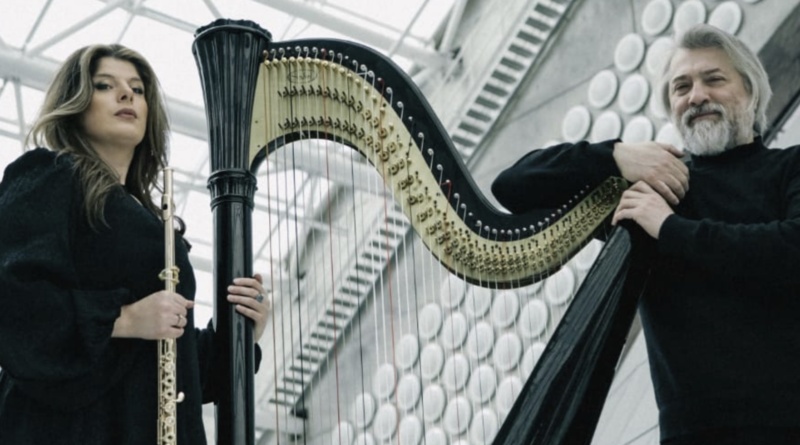Nicole Esposito & Çağatay Akyol New CD Release: INTERSECTIONS
Nicole Esposito is the Professor of Flute and Head of the Woodwind Area at the University of Iowa School of Music where she has been the recipient of the College of Liberal Arts and Sciences International Engagement and Collegiate Teaching Awards. She is also a Permanent Visiting Professor at the University of Chile and teaches and performs around the world as a Miyazawa Artist.
Çağatay Akyol is the principal harpist of the Presidential Symphony Orchestra in Ankara, Turkey and founder of the Anatolian music ensemble, Arpanatolia.
How did the concept for this album evolve?
Right before the pandemic started, I was fortunate to connect with the amazing Turkish harpist, Çağatay Akyol via Instagram. During this time when travel wasn’t possible, we made a few distanced recordings that were very popular on social media. In 2021, although travel was still restricted, we were able to meet in person for the first time when we recorded our first album “Dancing in Dreams”, music of Faure, Debussy, Ravel and Piazzolla. Since then, I have been fortunate to travel to Turkey several times. It is such a beautiful and culturally rich country. When we decided to record our second album, we came up with the idea of “Intersections” as Turkey is the literal intersection of Europe and Asia. I have always been intrigued and inspired by the lively dances and sorrowful melodies of folk music. Much of this album is rooted in folk traditions from Turkey and the surrounding region including Bulgaria, Armenia, Azerbaijan and the former Soviet Turkmen Republic. Both albums are published on the MSR Classics label and can found on most streaming platforms.
Can you tell us about the recording experience?
Both of our albums were recorded in the beautiful Voxman Concert Hall at the University of Iowa School of Music. The first time we recorded together was literally the first time we met and played together so in some ways, this second album was easier, as now we already knew each other well and had performed many concerts together. However, in other ways, it was more challenging, especially for Çağatay as many of the harp parts were adaptations from piano parts. The first recording was in the summer however we recorded “Intersections” in the winter right after the new year. We decided that recording in the summer is a better idea when it’s light and bright outside and you are full of energy, not in the bleak of winter right after being stuffed from all of the holiday meals! HA! All kidding aside, we tried to plan our sessions well to avoid getting overly tired. We recorded over four days for 4-5 hours each day. We made sure to listen to each take directly after we played it to decide what we liked and what we didn’t to save time in the editing process. Essentially, we were our own producers acting in real time. Thankfully we have expert recording technicians at the University of Iowa that were able to capture both the intimacy of the duo and the vibrancy of the hall.
What did you like best about your project?
I always enjoy bringing lesser performed or recorded pieces to light, so I am happy that we can feature repertoire from this region, which is often overlooked. I think both Çağatay and I are very colorful people and I think this comes across very well in our albums. We work hard to capture the spirit of each piece and composer by using a wide tonal palette, dynamic and color range and dramatic articulation. In this album you will even hear Çağatay drumming on the harp. I think our personalities blend well to create engaging storytelling for the listener.
What did you find the most challenging?
Every recording session can present unique challenges. For this one, I had accidentally bit my lip just before we started recording so it was quite swollen and uncomfortable to play for hours. Personally, it was challenging for me to keep my focus through this issue, as of course, when you are recording, you want your sound to be in its optimal state. Harp is a challenging instrument in general and lots of things can go wrong in a recording. A pedal can get stuck, strings can go out of tune quickly, etc. But the great thing about recording is that if it doesn’t go as planned, you can just do it again! It’s important to keep your focus on the final product and trust that everything will come together in the end.
INTERSECTIONS
MSR CLASSICS
Nicole Esposito, flute
Çağatay Akyol, harp
Sonata Adrian Shaposhnikov (1888-1967)
1. Andante con moto
2. Allegretto
3. Allegro molto
Anatolian Colors* Kemal Günüç (b. 1961)
Four Small Pieces for Flute and Harp
- 5/8
- 7/8
- 8/8
- 9/8
6 Stücke für Flöte und Klavier Fikret Amirov (1922-1984)
Trans. Esposito/Akyol
- Bardenweise
- Wiegenlied
- Tanz
- In den Bergen Aserbaidschans
- An der Quelle
- Nocturne
Melody Arno Babadjanian (1921- 1983)
Trans. Esposito/Akyol
Pieces for Flute and Piano Assen Karastoyanov (1893-1976)
Trans. Esposito/Akyol
- Prelude
- Haiduchka
- Echo
- Spinstress
- Harvest
- Ratchenitza
- Shepherds
- Interwoven Threads
- Lullaby
- Daytchka
Three Old Istanbul Songs
- Şehnaz Longa Santuri Etham Bey
- Katibim Anonim
- Nihavent Longa Kevser Hanim
Arr. Yusaf Yalçin
Trans. Akyol
*Written for Nicole Esposito and Çagatay Akyol
